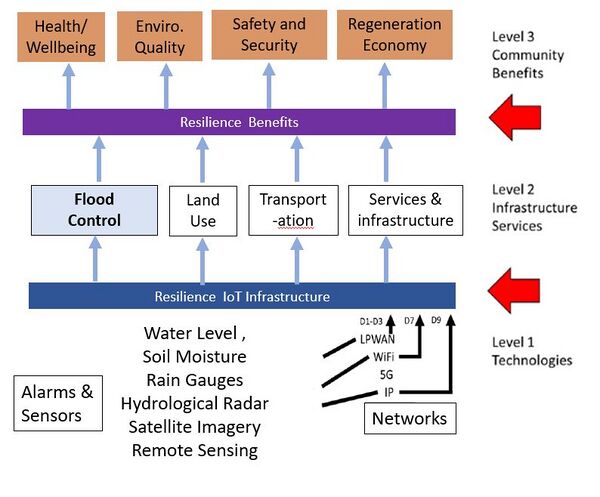Floods
| Public Safety | |
|---|---|

| |
| Sectors | Public Safety |
| Contact | Jiri Skopek |
| Topics | |
- Authors
The intensity of extreme rainfall has “sharply” increased over the past 20 years. While floods can be more regional in nature, satellite data show hydroclimatic extreme events are increasing in frequency, duration, and extent under warming conditions. Warmer temperatures increase evaporation, putting more moisture into the atmosphere that then gets released as rain or snowfall. It is also expected that, as the climate warms, flash floods will get “flashier,” meaning that the timing of the floods will get shorter while the magnitude gets higher.
For the cities and communities affected by flooding the prime concerns are multifaceted. The most obvious is the physical safety of the population. Rapidly rising waters can endanger lives, especially if floods strike with little warning. The dangers are not only during the event but also afterwards, due to potentially hazardous materials brought in or spread by the floodwaters.
Flooding can lead to soil erosion and loss of habitats, potentially endangering local ecosystems and biodiversity.
Sustained flooding and repeated inundation can cause serious damage to infrastructure such as roads, bridges, buildings, and utilities, hampering transport, the supply of essentials, and emergency response capabilities. Frequent floods can render some areas unsuitable for housing. This could lead to the displacement of residents, who may face difficulties in finding new homes and jobs. The stress and trauma associated with losing one's home or livelihood can have serious mental health impacts on affected individuals. Flooding can disrupt local businesses, causing economic damage and job losses. Damage to agricultural land can also impact the food supply.
There is also a danger to public health. Flood waters often contain hazardous materials, which can pose a public health risk. Moreover, standing water after a flood can become a breeding ground for mosquitoes and other disease vectors.
In light of these concerns, it's vital to develop and implement comprehensive flood risk management strategies, which could include infrastructure improvements, zoning changes, flood warning systems, community education, and measures to mitigate the impact of climate change.
Monitoring and Benchmarking Extreme Floods-KPIs
Total Precipitation - Metric: (days) is the most obvious indicator of the amount of rain. NOAA National Centers for Environmental Information https://www.ncei.noaa.gov/access/monitoring/climate-at-a-glance/global/mapping provides detailed information on both local and global total precipitation. The USGS national Water Data System https://waterdata.usgs.gov/nwis also provides access to real-time water data. EPA Climate Change Indicators: River Flooding https://www.epa.gov/climate-indicators/climate-change-indicators-river-flooding examines changes in the size and frequency of inland river flood events in the United States as well as coastal flooding https://www.epa.gov/climate-indicators/climate-change-indicators-coastal-flooding .
Flood Peak Height-Metric: (Height and time to flood peak) The peak flow is the maximum value of the flowrate due to a given rain event. Peak flow variation is defined by the relative error in peak flow between the peak flow of the catchment where the project intervention is located and the peak flow of a catchment without the intervention. This indicator can be calculated as the average value of a sample of peak flows deduced from a rain/runoff time series (typically one year) and may be obtained with observed runoff or simulated runoff.
Stormwater run-off- Metric: ( mm/%) A significant consequence of impermeable surfaces in urban areas is greater runoff, which can also lead to flooding. . Many factors are affecting the quantity of surface runoff, including soil characteristics, land use and vegetative cover, hillslope, and storm properties such as rainfall duration, amount, and intensity. Different methods for quantifying runoff include direct measurement, the curve number method, the rational method, the use of intensity-duration-frequency (IDF) curves, and process-based hydraulic modelling.
WDT - Water Detention Time- Metric: (hr) can measure increased infiltration. The detention time corresponds to the theoretically calculated time required for a given amount of water to flow from a given area to another area at a given flow rate.
Areas exposed to flooding- Metric: (ha) Flood maps and monitoring data such as the EPA Climate Change Indicators can identify areas affected by flooding.

Strategies
Reducing flooding in urban areas is an urgent task to reduce vulnerability for many cities and communities given the increasing frequency and intensity of floods as a result of climate change. Below are some strategies around prevention, preparedness, response, and recovery to mitigate flooding that cities can consider:
- Flood Risk Assessment: Performing an in-depth risk assessment to identify the most vulnerable areas in the city. Understanding which neighbourhoods, infrastructures, and communities are at the greatest risk is the first step in developing a targeted, effective flood resilience strategy. The flood information can now be integrated in a digital twin based operating system which enables both departmental and public access to information and collaboration. https://opencommons.org/Digital_Twin:_Emergency_Communication_Services.
- Infrastructure Improvements 1: Flood Barriers and Levees: Erecting flood walls, levees, or dykes in strategic areas to physically prevent floodwaters from reaching vulnerable areas.
- Infrastructure Improvements 2: Improving Drainage Systems: Enhancing the capacity of the city's drainage systems to handle increased rainfall. This might include widening and deepening drainage channels, installing additional storm drains, or implementing more advanced solutions such as smart, real-time controlled drainage systems.
- Infrastructure Improvements 3:Flood-Resistant Urban Design: Incorporating green infrastructure like parks, wetlands, and open spaces that can absorb rainwater and slow its journey to the river, reducing flood risk. Using permeable materials for pavements and other surfaces to allow water to seep through can also help.
- Land Use Planning: Integrating flood risk into city planning can effectively mitigate future flood damage. This may include stricter zoning laws for flood-prone areas, preventing new construction in high-risk areas, and creating buffer zones along water bodies.
- Early Warning Systems and Forecasting: Developing advanced flood forecasting systems and disseminating warnings in a timely manner to allow residents and authorities enough time to react. This includes investing in monitoring equipment, as well as software systems for data analysis and prediction.
- Emergency Preparedness: Developing comprehensive emergency response plans and regularly conducting drills so that citizens and authorities know what to do in the event of a flood. This includes evacuation plans, establishing emergency shelters, and stockpiling necessary supplies.
- Education and Awareness: Educating the community about the risks of flooding and how to respond can greatly reduce the impact. This might include distributing information about flood risks, conducting workshops, and promoting flood insurance.
- Building Resilience: Encouraging the construction of flood-resistant buildings in flood-prone areas, retrofitting existing structures to withstand floods, and using materials that dry out and clean easily.
- Post-Flood Recovery and Insurance: Implementing policies that facilitate quick and efficient recovery after a flood event. This includes providing insurance coverage and financial assistance for affected individuals and businesses, as well as implementing repair and rebuilding guidelines that will reduce the vulnerability of buildings to future floods.
It is important to note that these strategies should be based on a comprehensive understanding of the local context, including the city's geography, climate, built environment, social structures, and more. A multi-stakeholder approach, including citizens, government agencies, private sector, NGOs, and academics, can ensure a more effective flood resilience strategy.
Alarm systems and sensors technologies for flood warning
There are several types of alarm systems and sensor technologies that are used to provide early warnings for flooding. Here are some of them:
- Water Level Sensors: These are placed in bodies of water such as rivers, lakes, or dams to monitor the water levels. When the water level rises beyond a certain threshold, the sensor triggers an alarm.https://opencommons.org/Advanced_Flood_Warning_and_Environmental_Awareness
- Soil Moisture Sensors: These sensors are placed underground and are used to detect the moisture content in the soil. If the soil becomes overly saturated, indicating a potential flood, the sensor sends an alert.
- Rain Gauges: These devices measure the amount of rainfall in a specific area. If the rain gauge measures a high amount of rainfall in a short period, it can alert to the potential for flooding.https://opencommons.org/StormSense
- Hydrological Radar Systems: These use radar technology to track rainfall intensity and movement. These systems are particularly useful in predicting flash floods.
- Satellite Imagery and Remote Sensing: Satellites can provide large-scale views of weather patterns, river levels, and overall soil moisture. While not an "alarm" in the traditional sense, this technology plays a significant role in early flood detection and warning.
- Internet of Things (IoT) devices: These are devices that can be connected to the internet and can share data with each other.https://opencommons.org/Flood_Abatement In the context of flood detection, IoT devices could include water level sensors, rainfall gauges, and other such devices.https://opencommons.org/Empowering_Ruston_City_Services_Using_Wireless_Sensor_Networks These can send real-time data to a central system that analyzes the information and sends out alerts when necessary.https://opencommons.org/Flood_Judge
All these technologies can be combined for a more accurate prediction and warning system. The data gathered from these sources is often fed into predictive models that use machine learning and AI algorithms to predict when and where floods might occur, providing early warnings to potentially affected areas.
Case Studies:
Several cities around the world have implemented successful tools and strategies to reduce the impacts of flooding. Here are some examples:
Tokyo, Japan: Tokyo has implemented an extensive system of underground stormwater tanks and drainage channels to manage heavy rainfall and prevent urban flooding.https://www.japan.go.jp/kizuna/2021/01/utilizing_the_citys_underground_spaces.html The city also promotes green infrastructure, such as green roofs and permeable pavements, to absorb excess water.
Rotterdam, Netherlands: Rotterdam is well-known for its innovative water management strategieshttps://www.theguardian.com/sustainable-business/rotterdam-flood-proof-climate-change. The city has created water squares and reservoirs to store excess rainwater during heavy rainfall. Additionally, they have implemented smart water management systems that use real-time data to monitor and control water levels.
Hamburg, Germany: After experiencing severe floods in 1962 and 1976, Hamburg developed an extensive flood protection systemhttps://www.hamburg-port-authority.de/en/waterway/flood-defence. The city constructed flood barriers and dykes, as well as improving river and tidal defenses.
Copenhagen, Denmark: Copenhagen has implemented a combination of traditional flood defenses and green infrastructurehttps://climate-adapt.eea.europa.eu/en/metadata/case-studies/the-economics-of-managing-heavy-rains-and-stormwater-in-copenhagen-2013-the-cloudburst-management-plan. The city utilizes urban green spaces, green roofs, and permeable surfaces to retain rainwater and reduce the risk of flooding.
New York City, USA: After the devastating effects of Hurricane Sandy in 2012, New York City implemented a comprehensive plan called "OneNYC"https://www.nyc.gov/site/sustainability/onenyc/onenyc.page to address future flooding risks. The plan includes flood barriers, coastal defenses, and improved stormwater management systems.
Dhaka, Bangladesh: Dhaka has faced significant challenges due to monsoon floods and rising sea levels. To mitigate the impacts, the city has implemented a "Floating Garden" project https://www.nbsbangladesh.info/case_study/forest-protected-area-co-management/, which involves building gardens on floating beds made of water hyacinths. These gardens help absorb floodwaters and reduce the risk of inundation.
Singapore: Singapore has a comprehensive drainage system that includes canals, underground storage tanks, and detention ponds to manage heavy rainfall and prevent urban flooding.https://www.pub.gov.sg/drainage/floodmanagement The city also promotes the use of rainwater harvesting and green infrastructure.
Baltimore Baltimore https://opencommons.org/Baltimore_Community_Resilience_Hub is highly vulnerable to a range of natural hazards, including coastal storms, flooding, extreme heat, and high winds. These types of extreme events are likely to increase in frequency and magnitude over the coming years. In 2013, the City of Baltimore developed an integrated All Hazards Mitigation Plan (AHMP) and Climate Adaptation Plan. This Plan, called the Disaster Preparedness and Planning Project (DP3), links research, outreach, and actions to create a comprehensive system for addressing existing and future climate impacts.
Sponge Cities, China The Sponge City concept is a Chinese urban planning model that relies on natural stormwater management infrastructure, with a focus on flood control and mitigating urban development's impacts on hydrology and ecosystems. https://www.dw.com/en/china-turns-cities-into-sponges-to-stop-flooding/a-61414704
It's important to note that each city faces unique challenges, and successful flood management strategies may differ based on geographical, climatic, and socio-economic factors. Furthermore, since my knowledge is up to September 2021, there might be more recent developments and examples of cities implementing flood management strategies beyond that date.


